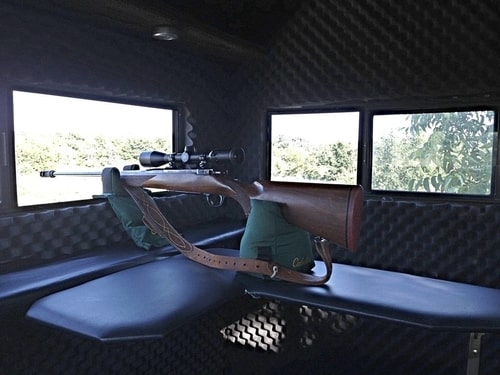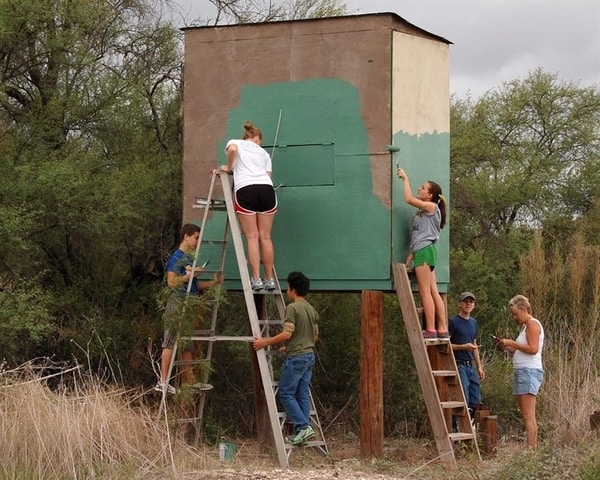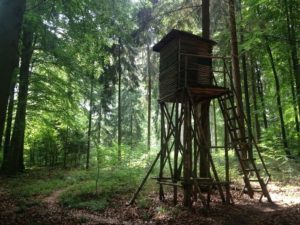Soundproofing deer blind – Soundproofing your deer blind is crucial for successful and silent hunts. By minimizing noise levels, you can remain undetected by wary deer and increase your chances of a successful shot.
In this comprehensive guide, we’ll explore the best materials, techniques, and considerations for soundproofing your deer blind, ensuring you have a stealthy and effective hunting experience.
Soundproofing Materials
Deer blinds are often used by hunters to conceal themselves from their prey. Soundproofing a deer blind is important to prevent the deer from hearing the hunter’s movements and becoming spooked. There are a variety of materials that can be used to soundproof a deer blind, each with its own advantages and disadvantages.
- Mass Loaded Vinyl (MLV): MLV is a heavy, flexible material that is very effective at blocking sound. It is often used in soundproofing walls and ceilings in buildings. MLV can be attached to the walls and ceiling of a deer blind using adhesive or staples.
- Acoustic Foam: Acoustic foam is a lightweight, porous material that is very effective at absorbing sound. It is often used in soundproofing studios and other environments where noise control is important. Acoustic foam can be attached to the walls and ceiling of a deer blind using adhesive or Velcro.
- Soundproofing Curtains: Soundproofing curtains are made from a heavy, dense fabric that is designed to block sound. They can be hung over the windows and doors of a deer blind to help reduce noise levels.
- Carpet: Carpet can help to absorb sound and reduce noise levels in a deer blind.
It can be placed on the floor of the blind or on the walls.
- Rugs: Rugs can also help to absorb sound and reduce noise levels in a deer blind. They can be placed on the floor of the blind or on the walls.
The following table compares the effectiveness, cost, and ease of installation of different soundproofing materials:| Material | Effectiveness | Cost | Ease of Installation ||—|—|—|—|| Mass Loaded Vinyl (MLV) | Excellent | High | Moderate || Acoustic Foam | Good | Moderate | Easy || Soundproofing Curtains | Good | Moderate | Easy || Carpet | Fair | Low | Easy || Rugs | Fair | Low | Easy |The best soundproofing material for a deer blind will depend on the specific needs of the hunter.
Hunters who need the most effective soundproofing possible should consider using MLV. Hunters who are on a budget may want to consider using acoustic foam or soundproofing curtains. Hunters who want an easy-to-install solution may want to consider using carpet or rugs.
Sound Absorption and Insulation
Soundproofing deer blinds involves controlling sound waves to minimize noise levels. Sound absorption and insulation are crucial techniques for achieving this.Sound absorption materials, such as fiberglass or acoustic foam, absorb sound energy, converting it into heat. This reduces the intensity of sound waves, making the space quieter.
Insulation materials, such as cellulose or spray foam, block sound waves from passing through, preventing noise from entering or escaping the blind.
Sound Absorption
- Sound absorption is crucial for reducing echoes and reverberation within the blind, which can amplify noise levels.
- Materials with high sound absorption coefficients (NRC) are more effective at absorbing sound.
- Placing sound absorption panels on walls and ceilings can significantly reduce noise levels.
Sound Insulation
- Sound insulation prevents noise from entering or leaving the blind, creating a quieter environment inside.
- Insulation materials with high STC (Sound Transmission Class) ratings are more effective at blocking sound.
- Adding insulation to walls, floors, and ceilings can significantly improve sound insulation.
Structural Considerations
Deer blinds are typically constructed using wood or metal frames covered with a layer of fabric or other material. The structural elements of a deer blind that contribute to sound transmission include:
The frame
The frame of the deer blind provides a direct path for sound to travel from the outside to the inside. To improve soundproofing, the frame can be reinforced with additional supports or by using thicker materials.
The walls
The walls of the deer blind are another major source of sound transmission. To improve soundproofing, the walls can be made thicker or by using materials that are more effective at blocking sound.
The roof
The roof of the deer blind can also contribute to sound transmission, especially if it is made of a thin material. To improve soundproofing, the roof can be made thicker or by using materials that are more effective at blocking sound.
The windows
The windows of the deer blind are a major source of sound transmission. To improve soundproofing, the windows can be made smaller or by using materials that are more effective at blocking sound.
The door
The door of the deer blind is another major source of sound transmission. To improve soundproofing, the door can be made thicker or by using materials that are more effective at blocking sound.By modifying or reinforcing these structural elements, it is possible to significantly improve the soundproofing of a deer blind.
Ventilation and Airflow: Soundproofing Deer Blind


Proper ventilation is crucial in soundproofed deer blinds to prevent the accumulation of stale air and moisture, which can negatively impact the soundproofing capabilities. Ventilation systems should be designed to minimize sound leakage while ensuring adequate airflow.
Ventilation System Design
- Install sound-absorbing materials within the ventilation system to dampen sound waves.
- Use multiple small vents instead of a single large vent to reduce the direct path for sound transmission.
- Position vents strategically to avoid creating direct sound paths to the exterior.
- Employ baffled or labyrinthine ventilation systems to create indirect sound paths and dissipate sound energy.
- Utilize acoustic silencers to further reduce sound leakage through the ventilation system.
Acoustic Treatment


Acoustic treatment involves the use of various materials and techniques to control the sound environment within a space. It plays a crucial role in improving sound quality and reducing noise levels in deer blinds, enhancing the overall hunting experience.
There are several types of acoustic treatments commonly employed in deer blinds:
Baffles, Soundproofing deer blind
Baffles are sound-absorbing panels that are strategically placed to block or redirect sound waves. They help to reduce reverberation and echo within the blind, creating a more controlled sound environment.
Diffusers
Diffusers are designed to scatter sound waves in multiple directions, preventing them from concentrating in specific areas. This helps to create a more even sound distribution, reducing the impact of standing waves and improving overall sound clarity.
Absorbers
Absorbers are materials that absorb sound waves, converting them into heat energy. They are typically made from porous materials such as fiberglass, foam, or mineral wool. Absorbers help to reduce noise levels and improve the acoustic quality of the blind.
Noise Reduction Techniques


To ensure a quiet and undisturbed hunting experience, employing effective noise reduction techniques is crucial. This involves addressing noise from various sources such as wind, rain, and animals.
One common approach is to use sound-absorbing materials within the deer blind. These materials, like acoustic foam or carpet padding, help absorb sound waves, reducing echoes and overall noise levels. Additionally, consider installing a noise-canceling curtain or blanket around the blind’s entrance to minimize sound transmission from outside.
Wind Noise Reduction
Wind noise can be a significant disturbance, especially in windy conditions. To mitigate this, install wind baffles or deflectors around the blind’s exterior. These baffles redirect wind currents, reducing noise and preventing it from entering the blind.
Rain Noise Reduction
Rain can create a constant drumming sound on the blind’s roof. To address this, use a sound-dampening material like roofing felt or rubber sheeting as an underlayment beneath the roof. This material absorbs sound waves, reducing the impact of raindrops on the roof.
Soundproofing a deer blind is crucial for staying concealed while hunting. One way to enhance the blind’s soundproofing capabilities is to add sound-absorbing materials, such as carpet or foam. Additionally, adding fat to deer meat can improve its flavor and tenderness.
Learn how to add fat to deer meat to make it more palatable. Returning to the topic of soundproofing, it’s important to seal any gaps or cracks in the blind’s structure to prevent sound from escaping.
Animal Noise Reduction
Animals moving around the blind can generate noise that can spook deer. To minimize this, avoid using noisy materials like metal or plastic for the blind’s exterior. Instead, opt for natural materials like wood or canvas that are less likely to create noise when animals come into contact with them.
If you’re planning a hunting trip and want to keep your deer blind as quiet as possible, there are a few things you can do. First, choose a location that is away from noise sources like roads or other hunters.
Second, use soundproofing materials to line the walls and ceiling of your blind. Third, make sure to close all the windows and doors when you’re inside. For more tips on soundproofing your deer blind, check out this article on deer creek reservoir ohio fishing .
Cost Considerations


The cost of soundproofing a deer blind can vary depending on the materials and techniques used. Some methods, such as using sound-absorbing panels, are relatively inexpensive, while others, such as structural modifications, can be more costly.
The following table compares the costs of various soundproofing materials and techniques:
| Material/Technique | Cost |
|---|---|
| Sound-absorbing panels | $10-$50 per panel |
| Mass-loaded vinyl | $1-$3 per square foot |
| Acoustic sealant | $10-$20 per tube |
| Structural modifications | Varies depending on the extent of the modifications |
When choosing a soundproofing method, it is important to consider the cost as well as the effectiveness of the method.
Final Thoughts
By implementing the soundproofing techniques Artikeld in this guide, you can create a deer blind that effectively minimizes noise and allows you to hunt with confidence. Remember to consider ventilation, structural reinforcement, and acoustic treatments to achieve optimal soundproofing results.
With a soundproofed deer blind, you’ll enjoy a more enjoyable and productive hunting experience, increasing your chances of success and leaving the woods with a sense of accomplishment.
Popular Questions
How much does it cost to soundproof a deer blind?
The cost of soundproofing a deer blind varies depending on the materials and techniques used. However, you can expect to spend anywhere from a few hundred dollars to over a thousand dollars, depending on the size and complexity of your blind.
What are the most effective soundproofing materials for deer blinds?
Mass Loaded Vinyl (MLV) and soundproofing blankets are highly effective soundproofing materials for deer blinds. They are dense and heavy, which helps to block and absorb sound waves.
How can I soundproof my deer blind without making it too bulky?
There are several ways to soundproof your deer blind without adding too much bulk. One option is to use soundproofing curtains or blankets, which can be easily hung or draped over the walls and windows of your blind. Another option is to use acoustic panels, which are thin and lightweight but effective at absorbing sound.







